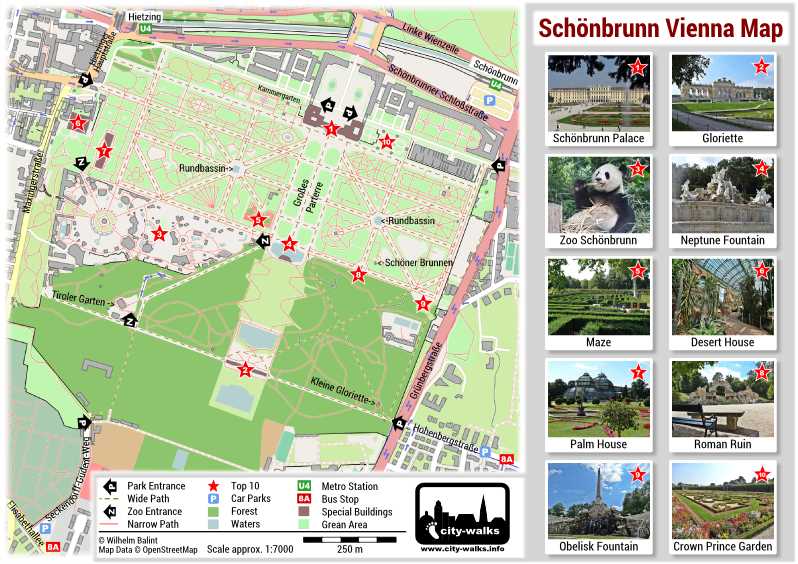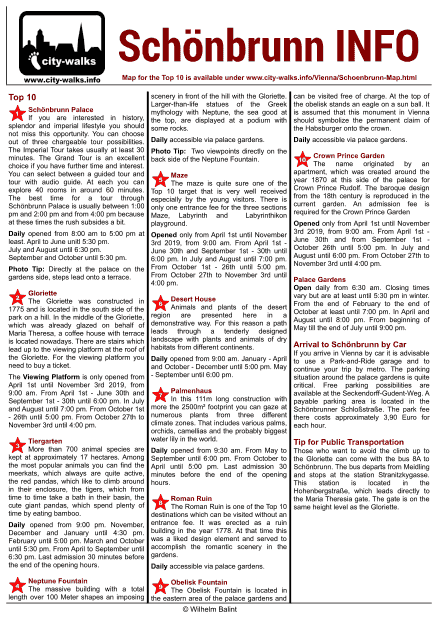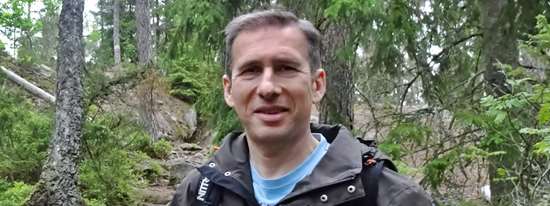Schönbrunn Palace Top 10
Together with the zoological garden the Schönbrunn Palace and the bordering park area belong to the most popular touristic targets in Vienna. In any case Schönbrunn is one of the most visited sights in Austria. About 4 million visitors to the palace are counted annually.
The origin of the history of Schönbrunn lies in a hunting lodge from the 17th century. The plans to build a counterpart to Versailles were never carried out. But they constructed the biggest palace in Austria, which served as an imperial summer residence in Vienna.
The present appearance is mainly influenced through the building activities organized by Empress Maria Theresa in the 18th century. Along with this, several of the well known attractions of the spacious palace gardens came into being. That includes, among others, the Gloriette, the Neptune Fountain, the Roman Ruin and the Obelisk Fountain.
In this free city-walks Top 10 Highlights listing you will find brief info and tips to the different attractions for young and elderly. Depending on your interest, you should calculate up to a whole day for your visit of the palace and the gardens. For the visit of the zoo you should reserve additionally at least half a day.
Schönbrunn Palace
If you are interested in history, splendor and imperial lifestyle, you should definitely visit Schönbrunn Palace. Although only a small part of the 1441 rooms are publicly accessible for visitors, you should not miss this opportunity. You can choose out of three chargeable tour possibilities. At the lowest priced State Apartments Tour you have the opportunity to explore some popular rooms of the palace with the help of an audio guide or a tour description.
At this tour you can see for example the Great Gallery, which impresses with golden stucco, ceiling frescoes and gold-plated chandeliers. Once it was the center for imperial celebrations and today there are still events taking place there. Also in the recent past historically important meetings occurred there, like the meeting between John F. Kennedy and Nikita Chruschtschow in the year 1961.
The Walnut Room impresses with its walnut panels and the gold-plated wall decorations in rococo style, which are still the originals. In this room the emperor held up to hundred audiences per day.
The Marie Antoinette Room was the dining room for the imperial family. The official and the private banquets were held there. At the presented laid out dinner table you can discover porcelain and silver from the imperial household.
The State Apartments Tour takes usually at least 40 minutes. The Palace Ticket Tour is an excellent choice if you have more time and interest. This tour is also available with an audio guide and lasts approximately 60 minutes. As an alternative to the audio guide, you can take part in the Maria Theresa tour. It has a duration of approximately 75 minutes and is available in English and German.
The Great Parterre is located directly in front of the palace. It is a vast space with accurate designed flower beds which are set up in baroque style. This area is the center of the palace gardens where large parts can be accessed without charge. There you can find also the further described highlights.
Gloriette
The Gloriette was constructed in 1775 and is located in the south side of the park on a hill. The building should remember the victory of Austria during the Seven Year War in the battle of Kolin.
In the middle of the Gloriette, which was already glazed on behalf of Maria Theresa, a coffee house with terrace is located nowadays. After the climb up to the hill you are able to rest on all weather conditions in an imperial environment and try one of the Viennese delicacy.
For all who still intend to get higher there are stairs which you can walk up to the viewing platform at the roof of the Gloriette. From there you can enjoy the view at the Schönbrunn Palace. The staircase is only open from the beginning of April till the end of October and you need to buy a ticket.
If you prefer not to climb up to this hill you have the following possibility via a side entrance which is well reachable by public transport. The bus line 8A goes from the traffic junction Meidling to the station Stranitzkygasse. From there you only need to walk a few minutes along the Hohenbergstraße to reach the Maria Theresia Gate. Because this entrance is on the same elevation as the Gloriette you are already in the highest section of the gardens and you avoid the climb. At this route you have the chance to take a glance at the -Kleine Gloriette-. Directly after passing the Maria Theresia Gate you can find it at the narrower path on the right side.
Zoo Schönbrunn
Although the Zoo, with the founding year 1752, is supposed to be the oldest still existing Zoo worldwide, you do not recognize this age at the animal enclosures. The focus is appropriate animal keeping according the latest findings. The 2 billion visitors per year confirm these efforts just the same as the reached top positions at comparisons with other zoos underline the popularity.
More than 700 animal species are kept at approximately 17 hectares. Among the most popular animals you can find the meerkats, which always are quite active, the red pandas, which like to climb around in their enclosure, the tigers, which from time to time take a bath in their basin, the cute giant pandas, which spend plenty of time by eating bamboo and of course a lot of other usual suspects such as the elephants, seals, penguins, giraffes ...
Further highlights include the rainforest house, which is an enormous glass house put over a mountain slope. There you can experience the simulated rainforest climate, with wisps of fog and roll of thunder, and observe the appropriate residents. In the bird house you have the chance to watch the animals without cage bars in between and walk through different landscapes like the African Savannah or the South American Tropics.
At weekends and during the holidays you should consider a remarkable inrush. To avoid the line up at the ticket office it is recommendable to buy the tickets online and save your time for the Zoo.
Neptune Fountain
The free accessible Neptune Fountain is located at the base of the hill in the axis between the palace and the Gloriette. The construction of the fountain was finished in the year 1780, shortly before Empress Maria Theresa passed away.
The massive building with a total length over 100 Meter shapes an imposing scenery in front of the hill with the Gloriette. Larger-than-life statues of the Greek mythology with Neptune, the sea good at the top, are displayed at a podium with some rocks.
Paths at the left and right of the fountain lead to the back side at the same height level as the rock formation. From there you are not only able to look through the waterfall, but also to shoot fantastic photos. There are two lookout points with a stunning view of the Schönbrunn Palace with the gardens in front. Please note the operating times to see the fountain in all its glory.
Maze
The maze is quite sure one of the Top 10 target that is very well received especially by the young visitors. It is nearby the Neptune Fountain and opened from the beginning of April till the end of October. There is an entrance fee for the three sections of which the maze consists.
The Maze itself is recreated after the original, which was laid out in the year 1720 but then cleared at the end of the 19th century. At 1700m² with around 630m hedges you can face the challenge and search for the right way to the center. The reward for the quest is waiting there in the form of an observation platform from where you can watch the other wandering people.
The labyrinth is particularly popular at the small visitors. Here the task is not only to find the right way, but additionally also to master different stations with playfully challenges. The pleasure is guaranteed at 2700m² for young and old.
Last but not least the Labyrinthikon playground for all who proof endurance and still have energy.
Besides the Vienna Zoo the Maze is probably the second most popular destination for children in the palace gardens.
Desert House
The Desert House is located nearby the Palm House and has its origin in the Sonnenuhrhaus. The Sonnenuhrhaus was built in the year 1904 on behalf of Emperor Franz Joseph I. and served in those days as protection for the exotic plants in the winter. In the years from 2000 to 2003 the Sonnenuhrhaus was rebuilt to the current Desert House. Animals and plants of the desert region are presented there in a demonstrative way.
For this reason a path leads through a tenderly designed landscape with plants and animals of dry habitats from different continents. This includes the doctor fishes which are located in an aquarium in the entrance area. All those who have no fear of contacts may put their hands in the aquarium in order to get nibbled by the fishes. The naked mole rat colony can be observed through a 70 m long glass tube labyrinth. These rodents do not look attractive and are blind, but their active social behavior is quite interesting.
Further highlights at the path are not only the several impressive cactuses but also the path through a cave with the opportunity to look closely at snakes, newts and other animals.
The Desert House is daily opened and charges an entrance fee.
Palm House
The Palm House, which can be found in the western parts of the palace gardens, was completed in the year 1882. In this 111m long construction with more the 2500m² footprint you can gaze at numerous plants from three different climate zones. That includes various palms, orchids, camellias and the probably biggest water lily in the world.
If you want to visit the Palm House you need to buy a ticket. But even those who do not visit the Palm House should walk through the surrounding park area and admire the gorgeous scenery. In the north of the Palm House you can find the well kept Palm House garden and in the south the Japanese garden right in front of the zoo.
Roman Ruin
The Roman Ruin is one of the Top 10 destinations which can be visited without an entrance fee. It was erected as a ruin building in the year 1778. At that time this was a liked design element and served to accomplish the romantic scenery in the gardens.
A basin with two statues in the middle is arranged in front of a round arch. The two statues with their pitchers symbolize the river gods of Danube and Enns.
In this part of the palace park the crowds vanish and due to that it is more relaxed. Who wants to rest in a quiet and romantic atmosphere, should search here for a free bench.
A bit hidden behind bush hedges, in close proximity to the ruin, is the unspectacular well house -Schöner Brunnen-. This fountain has been known since the 16th century and was the name giver for the Schönbrunn Palace.
Obelisk Fountain
The Obelisk Fountain is located in the eastern area of the palace gardens and can be visited free of charge. It was built in the year 1777. The obelisk is supported by 4 turtle sculptures standing on a pedestal. A grotto mountain with river gods is shown under the pedestal. At the operating times the water falls with a loud roar in cascades from the river gods into the basin.
At the top of the obelisk, which is approximately 31m high together with the fountain, stands an eagle on a sun ball. It is assumed that this monument in Vienna should symbolize the permanent claim of the Habsburger onto the crown.
Like in other parts of the gardens one straight avenue leads from the Obelisk Fountain directly to the palace. In the middle of this avenue one of the two large circular basins (Rundbassin) from the palace gardens can be found. A fountain sculpture is placed in the center of those basins.
Crown Prince Garden
The last attraction of the Top 10 is the Crown Prince Garden which is directly next to the palace of Schönbrunn at the east side. The name originated by an apartment, which was created around the year 1870 at this side of the palace for Crown Prince Rudolf.
The baroque design from the 18th century is reproduced in the current garden. Petite and low cut boxwood hedges surround neatly placed flower beds and fields of colored stones.
The garden is surrounded by a pergola, which is overgrown with wild vines. The pergola is interrupted by some pavilions and a modern viewing platform, from which you can admire the shapes of the flower beds from above.
The Crown Prince Garden opens every day from early April till the end of October. For the entrance you have to pay an admission fee.
Who prefers not to pay an admission, but nevertheless wants to admire garden art near the Schönbrunn palace should walk through the Kammergarten. This one is located directly at the west facade and is worth a visit even if it is by far not designed so elaborately and detailed.
¹) © Schloß Schönbrunn Kultur- und Betriebsges.m.b.H.
* This web page contains affiliate links / ads. More Information



